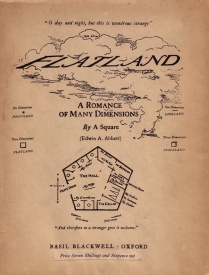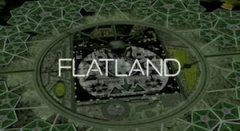 Here is another literary reference to mathematics. In fact, this story has often been called mathematical fiction. It is the satirical novella “Flatland: A Romance of Many Dimensions,” (1884) which was written by Edwin Abbott Abbott (1838-1926), an English schoolmaster and theologian. This story explores the nature of dimensions from the point of view of a two-dimensional world of geometry. The narrator is the humble square, who ends up visiting the one-dimensional world of Lineland as well as the three-dimensional world of Spaceland.
Here is another literary reference to mathematics. In fact, this story has often been called mathematical fiction. It is the satirical novella “Flatland: A Romance of Many Dimensions,” (1884) which was written by Edwin Abbott Abbott (1838-1926), an English schoolmaster and theologian. This story explores the nature of dimensions from the point of view of a two-dimensional world of geometry. The narrator is the humble square, who ends up visiting the one-dimensional world of Lineland as well as the three-dimensional world of Spaceland.
 He is even introduced to the world of Pointland. There are certainly some thought-provoking social elements to this geometry-filled story, and I recommend it to any math student who is studying geometry. Although the book was not ignored when it was published, it did not achieve great success. However, it experienced a surge in popularity when Albert Einstein’s Theory of General Relativity, and its introduction of the fourth dimension, was made known to the public. The text of the original books is made available to the public at WikiSource.
He is even introduced to the world of Pointland. There are certainly some thought-provoking social elements to this geometry-filled story, and I recommend it to any math student who is studying geometry. Although the book was not ignored when it was published, it did not achieve great success. However, it experienced a surge in popularity when Albert Einstein’s Theory of General Relativity, and its introduction of the fourth dimension, was made known to the public. The text of the original books is made available to the public at WikiSource.
 This story also inspired the making of a 30-minute animated movie, “Flatland: The Movie”. It was released and sold to the public as an educational edition DVD, private home-use DVD, and digital download in June, 2007. The educational edition is primarily intended for educators, teachers, schools and institutions that will use the movie as part of classes, lectures, and courses. Visit the movie’s website and watch the trailer. I found it to be a very contemporary and entertaining adaptation of this mathematical literary classic. I hope you do too.
This story also inspired the making of a 30-minute animated movie, “Flatland: The Movie”. It was released and sold to the public as an educational edition DVD, private home-use DVD, and digital download in June, 2007. The educational edition is primarily intended for educators, teachers, schools and institutions that will use the movie as part of classes, lectures, and courses. Visit the movie’s website and watch the trailer. I found it to be a very contemporary and entertaining adaptation of this mathematical literary classic. I hope you do too.


